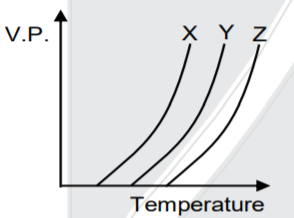State of matter having strongest inter-particle forces of attraction.
To answer the question about the state of matter having the strongest inter-particle forces of attraction, we can follow these steps:
1. Identify the States of Matter: The three primary states of matter are solids, liquids, and gases.
2. Analyze the Structure of Solids: In solids, the particles are tightly packed together. This means there are very few intermolecular spaces between them.
3. Evaluate Inter-particle Forces in Solids: Due to the tight packing of particles in solids, the forces of attraction between these particles are at their maximum. This strong attraction keeps the particles in fixed positions.
4. Examine Liquids: In liquids, the particles are not as tightly packed as in solids. There are some spaces between the particles, which means the forces of attraction are weaker than in solids but stronger than in gases.
5. Consider Gases: In gases, the particles are far apart with a lot of space between them. The forces of attraction are minimal because the particles can move freely and are not held together tightly.
6. Conclusion: Based on the analysis, the state of matter that has the strongest inter-particle forces of attraction is solids.
Final Answer:
The state of matter having the strongest inter-particle forces of attraction is solids.
---
The state of matter having the strongest inter-particle forces of attraction is solids.
Topper's Solved these Questions
- BOOK - ICSECHAPTER - MATTEREXERCISE - EXERCISE (F. Diagram based questions )4videos
MATTER
- BOOK - ICSECHAPTER - MATTEREXERCISE - EXERCISE (G. Give reasons for the following)4videos
MATTER
- BOOK - ICSECHAPTER - MATTEREXERCISE - EXERCISE (D. Match the following)1videos
MATTER
- BOOK - ICSECHAPTER - LANGUAGE OF CHEMISTRY EXERCISE - Exercise (Balance the following equations)4videos
LANGUAGE OF CHEMISTRY
- BOOK - ICSECHAPTER - PHYSICAL & CHEMICAL CHANGESEXERCISE - OBJECTIVE TYPE QUESTIONS (Physical & Chemical Changes)21videos
PHYSICAL & CHEMICAL CHANGES
Similar Questions
Which state of matter has least intermolecular forces of attraction?
View SolutionSelect the correct answer from A, B, C, D & E for each statement given below:
A: Solid B: Vaporization C: Ion D: Gases E: Heat
1. An atom or group of atoms - having a resultant charge.
2. The state of matter which has - least density & no free surfaces.
3. In Landolt's experiment - the form in which the chemical energy stored up in the reactants - is released.
4. The process of change of a liquid into vapour (gas) on heating,
5. The state of matter, where the inter-particle attraction between particles is maximum.View SolutionInter-particle force of attraction is weakest in gases.
View Solution
Compare the inter-particle space and forces of attraction between (a) and (b).View SolutionAre strong nuclear forces basically attractive?
View Solution '
'
A. Intermolecular force of attraction of X gt Y
B. Intermolecular force of attraction of X lt Y
C. Intermolecular force of attraction of Z lt X.
Select the correct option(s).View Solution '
'
A. Intermolecular force of attraction of X gt Y
B. Intermolecular force of attraction of X lt Y
C. Intermolecular force of attraction of Z lt X.
Select the correct option(s).View SolutionTwo electrically charged particles, having charges of different magnitudes, when placed at a distance from each other, experience a force of attraction .F. These two particles are put in contact and again placed at the same distance from each other. What is the nature of new force between them?
View Solution……………….. state of matter possesses the least inter-particle space.
View SolutionState whether this is true or false? The intermolecular force of attraction is the strongest in gases.
View Solution

